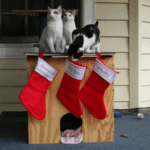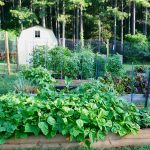Many people who care about the environment prefer a living Christmas tree, or a real Christmas tree in a pot, for the holidays.
Living Christmas trees differ from live Christmas trees in that they are more like house plants; they can be planted outdoors in the spring when the ground thaws, providing an attractive landscape plant. Or, you can grow them inside like a house plant.
Instead of discarding the Christmas tree after the holidays, a living Christmas tree become a living memory. It’s a sustainable way to enjoy the holidays without cutting down a real tree.
Buying a Christmas Tree in a Pot
Several types of evergreens can make good Christmas trees in pots, allowing you to enjoy a festive display even if you have limited space. Here are some popular choices:
- Dwarf Alberta Spruce (Picea glauca ‘Conica’): This compact and slow-growing evergreen has a classic Christmas tree shape. It’s well-suited for container planting and can be adorned with lights and ornaments.
- Norway Spruce (Picea abies): Choose a dwarf or slow-growing variety of Norway Spruce for container gardening. They have a traditional Christmas tree appearance and are relatively easy to care for.
- Dwarf Blue Spruce (Picea pungens ‘Glauca Globosa’): Known for its distinctive blue-green foliage, this compact spruce is a good choice for container planting. It maintains a rounded shape and has a slow growth rate.
- Dwarf Serbian Spruce (Picea omorika ‘Nana’): This slow-growing evergreen has a compact and conical form. It’s well-suited for containers and can be decorated for the holiday season.
- Dwarf Scotch Pine (Pinus sylvestris ‘Watereri’): Compact and slow-growing, the dwarf Scotch Pine is suitable for container gardening. It has dark green needles and a classic Christmas tree shape.
- Dwarf Korean Fir (Abies koreana): Varieties like ‘Silberlocke’ or ‘Horstmann’s Silberlocke’ are popular choices for container-grown Christmas trees. They have unique silver-white undersides to their needles.
When choosing a potted Christmas tree, consider the available space, climate, and the specific care requirements of the chosen evergreen. Make sure the pot has good drainage, and use a high-quality potting mix. Water the tree regularly, and provide it with the appropriate sunlight. Keep in mind that these trees are still living, so they should not be kept indoors for an extended period, as they need a period of dormancy. Rotate the tree periodically to ensure even growth, and transplant it to a larger pot as needed.
More Tips for Choosing the Right Christmas Tree in a Pot to Plant Outside
Many of the dwarf evergreens in the list above can be kept indoors as house plants. However, you may wish to plant them outdoors after the holidays or in the spring. Follow these tips to plant them outdoors.
Location for Your Tree
Look around your yard and decide before buying your tree where you will plant it. The small tree you buy this year will grow larger, so do not plant it too close to your house. Additionally, it may block the light and give your home a closed-in feeling. Plant your tree well away from existing structures.
Pre-Dig Your Planting Hole
If your area is prone to freezing in the winter, and the soil is too frozen to work, think about digging the planting hole in the early fall, before the ground freezes solid. Place the soil in buckets and store it in an outdoor location for the time when you are ready to plant your tree. Cover the hole with a board or tarp, and mark the spot with a safety cone so no one twists an ankle in it.
Light Requirements for Evergreen Trees
Many types of evergreen trees require full sunlight. Fir, pine and spruce need full sunlight. Full sunlight means six or more hours a day of direct, bright light.
Buying a Great Living Christmas Tree
Once you’ve chosen your site, and you’ve done your homework and selected a tree variety that will do well in your gardening zone, it’s time to purchase your living Christmas tree. Living trees are sold in pots or containers. Many garden centers carry them at this time of year. Select a tree that looks healthy, with full, green needles and little needle drop.
Buy your tree early. It’s a good idea to keep it in the garage or an enclosed but cool porch or shed for a week or two before bring it in the house. This helps the tree transition to the indoor climate. Water it while it is indoors.
Enjoying and Decorating Your Living Tree
Yes, you can — and should! — decorate your living Christmas tree. Many people like to place their potted Christmas tree inside a decorative container; this hides the unsightly plastic pot. You can also drop colorful cloth around the pot in a holiday color, or a Christmas tree skirt, around the container to hide it.
Place your living tree in a cool location. Try not to place it right next to a fireplace or heating vent. If it gets too hot, it can harm the tree, or dry it out quickly.
Do keep the bulbs and ornaments small and light. You don’t want to overwhelm or stress the tree with huge C7 light bulbs. Go for cool temperature bulbs if you can and small ornaments. If you hang tinsel on the tree, be prepared to pick it all off; garland may be a better (and easier) option!
Make sure to keep your tree watered during the holiday season.
After the Holidays: Planting a Living Christmas Tree
After the holidays are over, remove the ornaments, lights, tinsel, garland or tree skirt. Move your living tree back into the garage, porch or shed. Some experts recommend that you do not leave a living Christmas tree inside your home for more than 1 to 2 weeks; any longer, and the tree has trouble re-acclimating to the outdoors.
Like the transitional period when purchasing the tree, moving the tree to a sheltered, intermediate location helps it acclimate again to the outdoors. Water it lightly while it is in the garage, shed or porch.
Planting Evergreens
You will need to plant your tree as quickly as possible after a brief one to two week acclimation period in that covered area. As previously mentioned, it helps to dig the planting hole in the fall, when the ground is soft enough to be worked. If you can still dig the hole now, do so.
Remove the tree from its container. If the roots are tightly bound and encircling the container, use your fingers to gently prise them apart. Plant the tree only as deep and wide as the container it was in. Do not add fertilizer at this time. You can add compost if you have some. Replace the soil and gently tamp it down with your hands. I like to make a sort of wall with the soil around the outside of the planting hole to form a well near the tree. This helps water collect near the roots, where it is needed the most.
Mulch the area over the soil with shredded bark or wood chips.
Ready for Your First Living Christmas Tree?
Your local home and garden center is the best place to find a great living Christmas tree. Shop early, since you can keep your tree in the home for several weeks, and enjoy the holidays. Not only will you have a pretty tree but you will be planting a new tree – and helping the environment.




